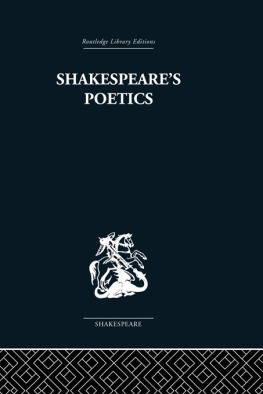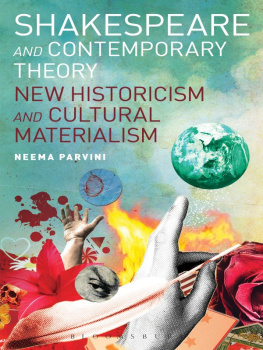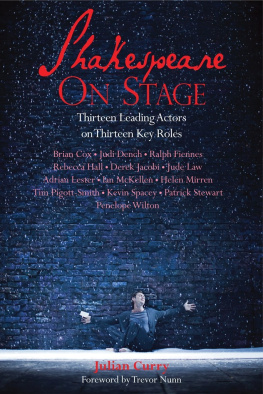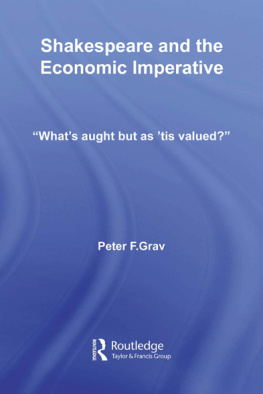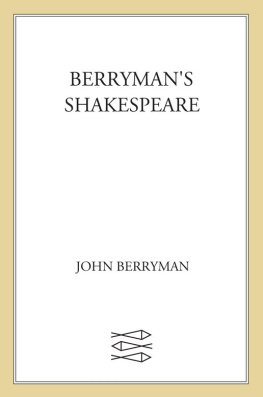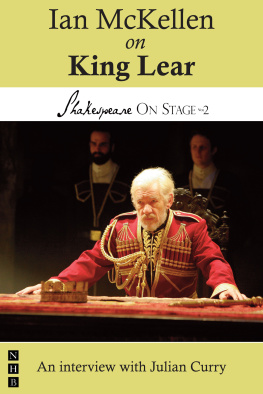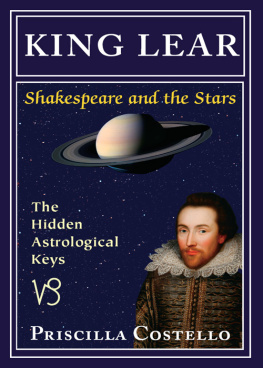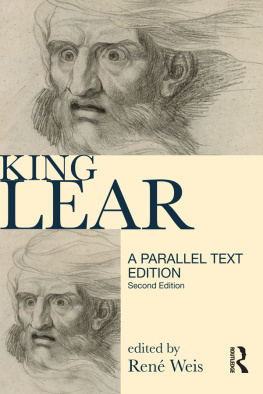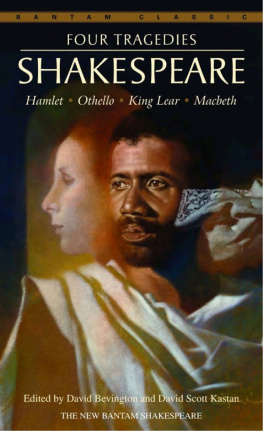Shakespeare William - Shakespeares poetics in relation to King Lear
Here you can read online Shakespeare William - Shakespeares poetics in relation to King Lear full text of the book (entire story) in english for free. Download pdf and epub, get meaning, cover and reviews about this ebook. City: London, year: 2005, publisher: Taylor & Francis (CAM);Routledge, genre: Science. Description of the work, (preface) as well as reviews are available. Best literature library LitArk.com created for fans of good reading and offers a wide selection of genres:
Romance novel
Science fiction
Adventure
Detective
Science
History
Home and family
Prose
Art
Politics
Computer
Non-fiction
Religion
Business
Children
Humor
Choose a favorite category and find really read worthwhile books. Enjoy immersion in the world of imagination, feel the emotions of the characters or learn something new for yourself, make an fascinating discovery.
- Book:Shakespeares poetics in relation to King Lear
- Author:
- Publisher:Taylor & Francis (CAM);Routledge
- Genre:
- Year:2005
- City:London
- Rating:3 / 5
- Favourites:Add to favourites
- Your mark:
- 60
- 1
- 2
- 3
- 4
- 5
Shakespeares poetics in relation to King Lear: summary, description and annotation
We offer to read an annotation, description, summary or preface (depends on what the author of the book "Shakespeares poetics in relation to King Lear" wrote himself). If you haven't found the necessary information about the book — write in the comments, we will try to find it.
Shakespeare William: author's other books
Who wrote Shakespeares poetics in relation to King Lear? Find out the surname, the name of the author of the book and a list of all author's works by series.
Shakespeares poetics in relation to King Lear — read online for free the complete book (whole text) full work
Below is the text of the book, divided by pages. System saving the place of the last page read, allows you to conveniently read the book "Shakespeares poetics in relation to King Lear" online for free, without having to search again every time where you left off. Put a bookmark, and you can go to the page where you finished reading at any time.
Font size:
Interval:
Bookmark:
King Lear in the Renaissance
I F I enumerate in a work of art those pure forms which carry primary meanings, I subject that work of art to pre-iconographical description. Thus, in describing King Lear , one might list the configurations or forms he finds in that particular play: pelicans, vipers, blind men, mad men.
To go beyond such elementary listing, and treat those configurations as carriers of secondary meanings, to treat, that is to say, not simply the thing itself but what that thing stands for beyond the primary level of mere denotation, is to enter on iconography. A pelican is a kind of bird. But conventionally it has been used as an emblem of Christ, who feeds or repasts his flockthe phrase belongs to Laertes, in Hamlet with his own lifes blood. A winged man, a lion, an ox, an eagle, these, in conjunction, in Christian literature and art, figure by convention the Four Evangelists. The image of a fish betokens Jesus Christ. In vaticinal poetry, men and women are symbolized in the character of animals and birds. The magpie may stand for an odious priest, and the dragon for any Welsh prince; or, if the time is propitious, for Owen Glendower; or later, Robert Aske, the Lincolnshire rebel; or, it may be, for Anti-Christ, the Dragon of Babylon.
The form, then, is charged with a secondary meaning. It has become an image. King Lear , of course, is compounded of images. It is the business of the iconographer to describe them.But to see in those images the manifestation of underlying principles, symbolic of the basic attitude of a nation, or class, or era; to get at the psychology, the state of mind, which may be implicit or even unconscious, that led Shakespeare and his fellows to see and use the pelican, say, as a symbol pat to their purpose, this is the business of iconology. Ideally, the iconologist will muster many documentspoems, sermons, proverbs, ballads, picturesconcurrent in time with the work he has chosen to discuss, and revealing, in their use of like symbols, pretty much the same notion of the way the world goes.
The documents at issue, if one is treating of the Renaissance, are likely, all of them, and whatever their formal nature, to be illustrative or graphic in manner, if not expressly pictorial. What they would communicate, they are likely to couch in the form of a similitude or image, and this on the principle, as Bacon puts it, that that which is sensible more forcibly strikes the memory and is more easily imprinted on it than that which is intellectual. To stigmatize pride: si grand orgueil is nothing. To embody pride in the Tower of Babel, as Holbein does in his leones Historiarum , is to yoke the abstraction to earth. The bizarre notion of a virgin who conceives and remains a virgin still is only a piece of mystification until it is represented as the garden enclosed, the sealed fountain, the shut gate, the immaculate mirror. That man is sometimes feeble or vicious is only a commonplace, not really apprehensible, in a sense not really true, until analogy demonstrates and so approves it:
How from the finny subject of the sea
These fishers tell the infirmities of men.
( Pericles, 2.1.52f.)
Figures are useful, indispensable even, in that they reduce intellectual conceptions to sensible images. What is more, resort to them is a matter of innate predilection.
Euen litle children as soone as they can vse their hands at libertie, goe with a Cole to the wall, indeuoring to drawe the forme of this thing or that,
and for the reason, according to Samuel Daniel, that to
We have of course our images also, although, with a kind of heroic fatuity, we have sought since the late seventeenth century more and more to dispense with figurative language, have denied, at least implicitly, that we lean on it at all. But even if you concede that Avogadros Hypothesis is really a kind of figure, you will agree, I suppose, that the terms in which it is couched are nothing like so analogical as those which the Renaissance astronomer Robert Recorde employed to describe the constellation Andromeda, whose head lyeth on the navel of Pegasus. Recorde did not seek to be poetic, in the facile and faintly pejorative sense of the word. He might have said simply, with Ben Jonson in Discoveries , that Whosoever loves not Picture is injurious to Truth. Himself a partisan of the truth, he attended and necessarily to the metaphorical way.
The mind of Recorde, like that of ShakespeareI would add, the mind of the Renaissanceis enamoured of what is literal and concrete. Rien ne vit qu en dtail . The extraordinary popularity of the emblem defined by Francis Quarles as a silent Parable
Not only the emblem flourished, but exemplary literature in general. The reasons in each case are essentially the same. If you would instruct, you must dramatize, give your precept some palpable, at best some historical, antecedent:
For the remembrance of matters past, furnisheth men with examples sufficient to guide and direct them in their consultations of future things.
Hence the vogue of florilegia , and the De Casibus theme:
Stately and proud, in riches and in traine,
Whilom I was powerfull and full of pompe,
But what is he, whome rule and emperie
Have not in life or death made miserable?
( Edward II , 11. 1879-82)
If you would clarify, you must levy on metaphor: Poesie is a speaking picture, and picture dumb Poesie. When Pericles, in Shakespeares play, would express his love for Thaisa, he is not content simply to declare it. He must exemplify it, rather, as his knightly competitors do, by means of a device or impresa :
A withered branch, thats only green at top;
The motto, In hac spe vivo. (2.2.43f.)
When Francis Bacon, assisting at the trial of Essex, would make clear the nature of that noblemans ill-fated rebellion, he does not argue in terms of a disembodied principle: words, words,
The age of Shakespeare finds its way to truth by means of indirections, through analogies and images, those stricken metaphors which Sprat and the Fellows of the Royal Society sought to banish from wits commonwealth. As you might expect, the images tend to recur. The contracted similitudes of Taverner or Whitney are those of the dramatist also. They are likely, moreover, to shadow the same understanding. Whitney, in A Choice of Emblemes (1586), will illustrate the twin resource of Scripture, to save, or serve only for springes and snares, by presenting a single flower, fruitful of honey and poison. And after Whitney, Shakespeare or, more precisely, Friar Laurence, in Romeo and Juliet:
Two such opposd kings encamp them still
In man as well as herbs, grace and rude will.
(2.3.27f.)
Ben Jonsons Sir Politic Would-Be is alive also to the sense of Whitneys gloss, familiar also with the emblem which gives it a local habitation:
The spider and the bee oft-times
Suck from one flower.
( Volpone , 2.1.30f.)
Shakespeares Escalus, in a celebrated crux, remarks of Claudio, in Measure for Measure , and, presumably, of the deputy who has sentenced him to death:
Some rise by sin, and some by virtue fall.
Some run from brakes of ice, and answer none,
And some condemned for a fault alone.
(2.1.38-40)
But if Escalus is cryptic, it is not by intention. His purpose is rather, by means of a speaking picture, to clarify; as Whitney, dilating on the sovereign power of chance, would clarify also, and in similar manner. Observing the fox on ice, as it did to peeces brake, he finds in that misadventure the moral:
No subtill crafte will serue,
When Chaunce doth throwe the dice.
The many collections of parables and semblables drawn, most of them, at least purportedly, from the wisdom of the ancientsagain, the penchant for analogy, or precedentdemonstrate also their connexion with the greater writing of the age, help even to form it. Thus the Chiliades of Erasmus moralizes, before the fact, the unhappy case of Macbeth: Quod factum est, infactum fieri non potest. The thynge that is done can not be vndone.
Font size:
Interval:
Bookmark:
Similar books «Shakespeares poetics in relation to King Lear»
Look at similar books to Shakespeares poetics in relation to King Lear. We have selected literature similar in name and meaning in the hope of providing readers with more options to find new, interesting, not yet read works.
Discussion, reviews of the book Shakespeares poetics in relation to King Lear and just readers' own opinions. Leave your comments, write what you think about the work, its meaning or the main characters. Specify what exactly you liked and what you didn't like, and why you think so.

